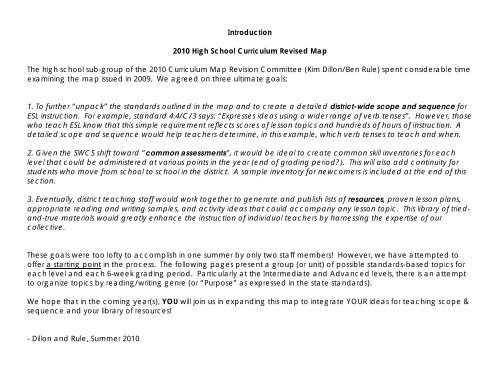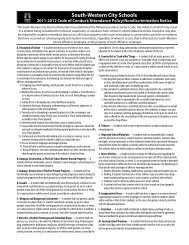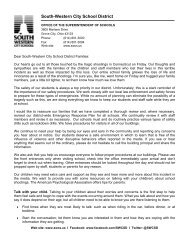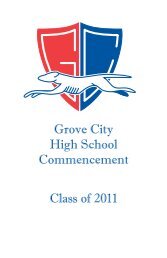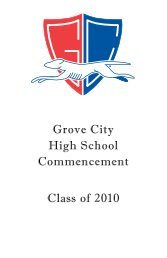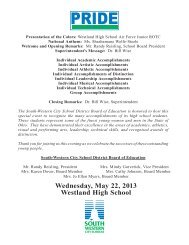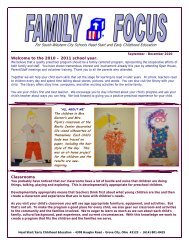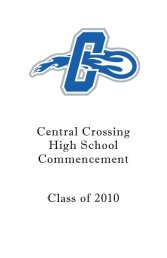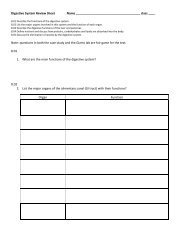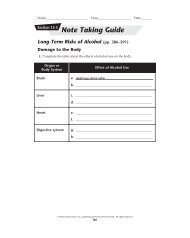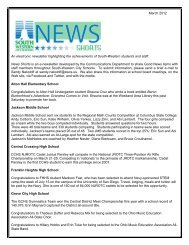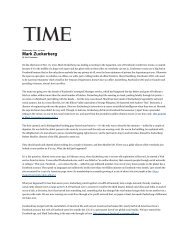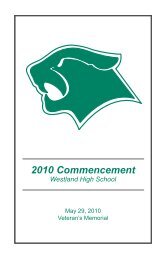ESL Curriculum Mapping
ESL Curriculum Mapping
ESL Curriculum Mapping
You also want an ePaper? Increase the reach of your titles
YUMPU automatically turns print PDFs into web optimized ePapers that Google loves.
Introduction<br />
2010 High School <strong>Curriculum</strong> Revised Map<br />
The high school sub-group of the 2010 <strong>Curriculum</strong> Map Revision Committee (Kim Dillon/Ben Rule) spent considerable time<br />
examining the map issued in 2009. We agreed on three ultimate goals:<br />
1. To further “unpack” the standards outlined in the map and to create a detailed district-wide scope and sequence for<br />
<strong>ESL</strong> instruction. For example, standard 4.4/C/3 says: “Expresses ideas using a wider range of verb tenses”. However, those<br />
who teach <strong>ESL</strong> know that this simple requirement reflects scores of lesson topics and hundreds of hours of instruction. A<br />
detailed scope and sequence would help teachers determine, in this example, which verb tenses to teach and when.<br />
2. Given the SWCS shift toward “common assessments”, it would be ideal to create common skill inventories for each<br />
level that could be administered at various points in the year (end of grading period?). This will also add continuity for<br />
students who move from school to school in the district. A sample inventory for newcomers is included at the end of this<br />
section.<br />
3. Eventually, district teaching staff would work together to generate and publish lists of resources, proven lesson plans,<br />
appropriate reading and writing samples, and activity ideas that could accompany any lesson topic. This library of triedand-true<br />
materials would greatly enhance the instruction of individual teachers by harnessing the expertise of our<br />
collective.<br />
These goals were too lofty to accomplish in one summer by only two staff members! However, we have attempted to<br />
offer a starting point in the process. The following pages present a group (or unit) of possible standards-based topics for<br />
each level and each 6-week grading period. Particularly at the Intermediate and Advanced levels, there is an attempt<br />
to organize topics by reading/writing genre (or “Purpose” as expressed in the state standards).<br />
We hope that in the coming year(s), YOU will join us in expanding this map to integrate YOUR ideas for teaching scope &<br />
sequence and your library of resources!<br />
- Dillon and Rule, Summer 2010
Newcomer/Pre-Functional: Student is brand new to English and may have limited literacy skills in<br />
primary language. Administer the Learning Needs Inventory as an assessment tool to guide which<br />
specific skills students need to learn and/or master in order to move up to the Beginner level.<br />
PRELITERACY SKILLS: All require extensive teacher support.<br />
Reading Readiness Skills<br />
Identifies differences in basic shapes,<br />
signs & symbols according to size and<br />
directionality.<br />
Identifies similarities in basic shapes,<br />
signs & symbols according to size and<br />
directionality.<br />
Understands left to right directionality.<br />
Understands that English text is read left<br />
to right directionality.<br />
Understands how to show progressive<br />
order/sequence from small to large,<br />
beginning to end, etc.<br />
Identifies differences between Upper &<br />
Lowercase letters.<br />
Recognizes the days of the week and<br />
months of the year.<br />
Recognizes and can match vocabulary<br />
to pictures of basic body parts.<br />
Writing Readiness Skills<br />
Understands proper position for holding<br />
paper.<br />
Holds a pencil correctly.<br />
Draws basic strokes.<br />
Writes left to right directionality and.<br />
Writes letters in name legibly, using<br />
capitals, and stays on the line.<br />
Writes on the line with correct spacing<br />
between letters and words.<br />
Writes the alphabet using models.<br />
Understands that sentences begin with a<br />
capital letter.<br />
Understands that sentences end with a<br />
period.<br />
Is able to copy date: 1/01/10.<br />
Communication Readiness Skills<br />
Is able to recite name and address.<br />
Comprehends and follows modeled<br />
everyday Yes/No questions , such as<br />
“Do you understand?”<br />
Comprehends and follows modeled<br />
everyday questions, such “May I go to<br />
the bathroom.”<br />
Comprehends and follows modeled<br />
everyday verbal classroom directions,<br />
such as “Take out a pencil.”<br />
Comprehends and follows modeled<br />
directions on signs, such as “Exit.”<br />
Understands and performs modeled<br />
behaviors for basic conversation and<br />
dialogue.<br />
Comprehends and responds to<br />
modeled oral questions such as “What<br />
is your name?”
Reading Readiness Skills<br />
Recognizes and can match vocabulary<br />
to pictures of basic clothing items.<br />
Recognizes primary colors.<br />
Recognizes high frequency vocabulary<br />
associated with everyday school,<br />
including basic routine and school<br />
grounds.<br />
Recognizes high frequency vocabulary<br />
associated with everyday family and<br />
friends.<br />
Recognizes high frequency vocabulary<br />
associated with everyday community.<br />
Recognizes basic units of money.<br />
Reads a basic class schedule in terms of<br />
order of classes and where to go.<br />
Is able to understand a map according<br />
to directions north, south, east, and<br />
west.<br />
Differentiates simple directions, such as<br />
Circle vs. Underline.<br />
Is able to read a basic graphic<br />
organizer, such as Venn.<br />
Writing Readiness Skills (cont.)<br />
Writes numbers 1- 20 and words 1-10.<br />
Knows how to circle, underline, or place<br />
an X when asked in directions.<br />
Has a general understanding of how to fill<br />
out basic forms asking for personal<br />
information.<br />
Writes basic simple present tense<br />
sentences: “Hello, my name is __.”<br />
Understands basic subject pronouns: I,<br />
you, he, she, it, we, they.<br />
Has a general understanding of the<br />
simple present tense verb To Be through<br />
use and repetition.<br />
Has a general understanding of the<br />
simple present tense verb To Have<br />
through use and repetition.<br />
Uses high frequency present tense verbs<br />
such as To Have, To Go, To Do.<br />
Has a basic understanding of the<br />
differences between past, present, and<br />
future.<br />
Understands basic simple present<br />
negative forms.<br />
Is to fill out a basic graphic organizer,<br />
such as Venn.<br />
Communication Readiness Skills (cont)<br />
Is able to recite the alphabet.<br />
Comprehends and responds to<br />
modeled oral questions such as “How<br />
are you today?”<br />
Has phonetic awareness and<br />
differentiates between consonants and<br />
vowels.<br />
Is able to recite the numbers 1-20.<br />
Is able to recite the days of the week.<br />
Is able to tell basic time and/or<br />
understand class schedule according<br />
to time.<br />
Is able to express basic feelings, such as<br />
“I don’t feel well” or “I am confused.”<br />
Is able to demonstrate knowledge of<br />
directionality by pointing left to right, up<br />
and down, etc.<br />
Is able to recite names of class subjects<br />
and teachers.<br />
Comprehends and responds<br />
accordingly to information questions<br />
using who, what, where, when, why.<br />
Understands the basics of computer<br />
usage.
BEGINNER - TERM 1A-B<br />
UNIT: BASIC PERSONAL INFORMATION (Simple Sentences)<br />
READ (3.4): Purpose<br />
Simple Poetry (phonics)<br />
Narrative Fiction<br />
(Big Dog & Dan)<br />
Identifies purposes for<br />
reading, including gaining<br />
information, to perform a<br />
task, for enjoyment or for a<br />
literary experience. 3.4/A/2<br />
WRITE (4.2): Purpose<br />
Simple Sentences<br />
Write Date<br />
Handwriting<br />
Writes basic personal<br />
information. 4.2/A/1<br />
READ (3.2): VOCAB<br />
Spell #1-20<br />
Colors<br />
Ordinal Numbers<br />
Months/Days<br />
Seasons<br />
Vowel Samples<br />
Digraph Samples<br />
ID basic words – colors, numbers, directions<br />
3.2/A/1<br />
WRITE (4.3): Process<br />
Uses prewriting strategies to generate and<br />
organize ideas for writing about a given<br />
topic, with extensive support. 4.3/A/1<br />
READ (3.1&3.3): Strategies & Comprehension<br />
Short vowels<br />
Long vowels<br />
Digraphs (sh, th, ch, ng)<br />
Sight Word Lists A & B<br />
Sequence<br />
Author Purpose(fun/inform/direct.)<br />
Fiction v Non-Fiction<br />
Illustration v Print : 3.1/A/1<br />
Alphabet, Letter-Sound correspondence, print direction (3.1/A/2)<br />
Follows simple written directions with extensive support. 3.3/A/1<br />
Recalls and sequences information from fictional and non-fictional texts<br />
with support. 3.3/A/2<br />
WRITE (4.1&4.4): GRAMMAR/Conventions & Structure<br />
Be / Have Verbs – present<br />
Be verb questions (present): WH question words<br />
Present Progressive Tense<br />
Possessive Pronouns<br />
Nouns -> Pronouns in simple sentences<br />
I.D. Subject of Sentence<br />
Writes numbers and letters 4.1/A/1<br />
Writes with correct directionality and spacing. 4.1/A/2<br />
Uses basic, high-frequency vocabulary and simple structures to<br />
communicate ideas. 4.4/A/2
BEGINNER - TERM 2A-B FALL OGT<br />
UNIT: Biography / My House (SENTENCES) / What are you doing?<br />
READ (3.4): Purpose<br />
Non-Fiction<br />
ID fiction v non-fiction<br />
Identifies age-appropriate,<br />
simplified texts as fact or<br />
fiction. 3.4/A/4<br />
READ (3.2): VOCAB<br />
House/Yard<br />
Location Words<br />
Verbs<br />
Sight words C<br />
synonyms/antonyms<br />
Recognizes and comprehends sight words,<br />
signs and symbols found in everyday life.<br />
3.2/A/2<br />
READ (3.1&3.3): Strategies & Comprehension<br />
Build background<br />
Dictionary<br />
Develops and uses background knowledge to gain meaning from texts, with<br />
extensive support. 3.1/A/3<br />
Begins to use dictionary and/or picture dictionary (bilingual or English) to help<br />
identify meaning of words, with extensive support. 3.1/A/6<br />
Answers literal and evaluative questions about age-appropriate, simplified<br />
texts, with support. 3.3/A/3<br />
Reads and follows simple, one-step written instructions. 3.3/A/1<br />
WRITE (4.2): Purpose<br />
Non-Fiction<br />
Journals<br />
Simple sentences<br />
Writes simple personal and<br />
reflective journal entries, with<br />
extensive support. 4.2/A/2<br />
WRITE (4.3): Process<br />
Brainstorm<br />
Uses prewriting strategies to generate and<br />
organize ideas for writing about a given topic,<br />
with extensive support. 4.3/A/1<br />
Drafts complete sentences based on prewriting<br />
activities, with extensive support.<br />
4.3/A/2<br />
WRITE (4.1&4.4): GRAMMAR/Conventions & Structure<br />
More Present Continuous… negatives/questions<br />
Present Tense (positive)<br />
NOT negatives/questions<br />
ID Subject/Verb : be/have<br />
in vs. on (date)<br />
Writes simple sentences with correct capitalization, punctuation, spelling and<br />
grammar following a model. 4.1/A/3<br />
Uses basic, high-frequency vocabulary and simple structures to communicate<br />
ideas. 4.4/A/2
BEGINNER - TERM 3A-B<br />
UNIT: Family / Holidays (LETTER / NARRATIVE)<br />
READ (3.4): Purpose<br />
Fictional Narrative/Letters<br />
Identifies information in simple<br />
diagrams, charts, graphs and<br />
maps. 3.4/A/6<br />
READ (3.2): VOCAB<br />
Family<br />
Adjectives<br />
Holidays<br />
Classify: noun/verb/adjective<br />
Synonym / Antonym<br />
Classifies high-frequency words into categories<br />
with help of visuals and scaffolding. 3.2/1/3<br />
READ (3.1&3.3): Strategies & Comprehension<br />
5 reading strategies (predict, question, clarify, summarize, visualize)<br />
Compare/contrast<br />
Uses graphics to help identify purpose and meaning of texts, with support.<br />
3.1/A/4<br />
Demonstrates comprehension of age-appropriate, simplified texts using<br />
pictures / graphic organizers with support. 3.3/A/4<br />
WRITE (4.2): Purpose<br />
Personal Letter<br />
Narrative<br />
WRITE (4.3): Process<br />
Brainstorm<br />
Self-Edit Checklist<br />
WRITE (4.1&4.4): GRAMMAR/Conventions & Structure<br />
Present: Negative/Questions<br />
Present v Present Continuous<br />
noun/verb/adjective<br />
Contractions<br />
Writes simple notes and letters,<br />
with extensive support. 4.2/A/3<br />
Uses prewriting strategies to generate and<br />
organize ideas for writing about a given topic,<br />
with extensive support. 4.3/A/1<br />
Drafts complete sentences based on prewriting<br />
activities, with extensive support.<br />
4.3/A/2<br />
Reviews and revises draft sentences for<br />
content, organization and vocabulary, with<br />
extensive support.<br />
4.3/A/3<br />
… Uses the table of contents, glossary, captions and illustrations in ageappropriate,<br />
simplified texts to identify basic information, with support. 3.4/A/9<br />
Writes most common contractions correctly 4.1/A/4
BEGINNER - TERM 4A-B OTELA<br />
UNIT: Weather / Culture (Paragraphs - NON-FICTION)<br />
READ (3.4): Purpose<br />
Non-Fiction<br />
Author Purpose<br />
Identifies purpose of ageappropriate<br />
and grade-level<br />
texts, with support. 3.3/A/6<br />
Reads age-appropriate,<br />
simplified informational texts,<br />
and identifies main ideas and<br />
supporting details. 3.4/A/5<br />
READ (3.2): VOCAB<br />
Irreg Past<br />
Irreg Plural<br />
Weather<br />
Culture<br />
Recognizes synonyms and antonyms of highfrequency<br />
words, with considerable support.<br />
3.2/A/4<br />
READ (3.1&3.3): Strategies & Comprehension<br />
5 reading strategies (predict, question, clarify, summarize, visualize)<br />
Main Idea + Details<br />
Prediction<br />
Recognizes repeats and/or reads aloud rehearsed words, phrases, sentences<br />
and basic reading materials, with extensive support. 3.1/A/5<br />
Predicts content, events and/or outcomes in age-appropriate, simplified texts,<br />
using illustrations, previous information from texts, and prior experiences, with<br />
extensive support.3.3/A/5<br />
WRITE (4.2): Purpose<br />
Expository/Informative<br />
Paragraphs<br />
Main Idea + Detail<br />
WRITE (4.3): Process<br />
Self-Edit Check list<br />
Take Notes<br />
Graphic Organizers (timeline, web, Venn)<br />
WRITE (4.1&4.4): GRAMMAR/Conventions & Structure<br />
Past Tense (pos/neg/question)<br />
Past Contractions<br />
Plurals<br />
Compound Words<br />
Comma Series<br />
Writes simple narratives and<br />
poems, with extensive support.<br />
4.2/A/4<br />
Edits written work for mechanics and structure,<br />
with extensive support. 4.3/A/4<br />
Writes most common contractions correctly. 4.1/A/4
BEGINNER - TERM 5A-B SPRING OGT<br />
UNIT: PERSONAL NARRATIVE<br />
READ (3.4): Purpose<br />
Personal Narratives<br />
Context Clues<br />
Plot/Character/Setting/Conflict<br />
ID Fiction v Non-Fic<br />
Reads age-appropriate, simplified<br />
literary texts, and identifies basic<br />
components such as theme, main<br />
characters, and setting. 3.4/A/7<br />
Tion<br />
WRITE (4.2): Purpose<br />
Personal Narrative<br />
Notes<br />
Summary – Main Idea + Detail<br />
Paragraphs<br />
READ (3.2): VOCAB<br />
After School Activities<br />
Irreg Past<br />
Emotions<br />
Uses context clues to determine meaning of<br />
new vocabulary within familiar context, with<br />
support. 3.2/A/5<br />
WRITE (4.3): Process<br />
Self-Edit / Peer-Edit<br />
READ (3.1&3.3): Strategies & Comprehension<br />
Summarize<br />
Begins to use dictionary and/or picture dictionary (bilingual or English) to<br />
help identify meaning of words, with extensive support. 3.1/A/6<br />
Summarizes content of age-appropriate, simplified texts by identifying main<br />
ideas and some supporting details, with extensive support. 3.3/A/7<br />
WRITE (4.1&4.4): GRAMMAR/Conventions & Structure<br />
Asking Y/N questions<br />
Pres v Past v Pres Prog<br />
Comma Series<br />
Compound Sentences<br />
Writes as a learning strategy, such<br />
as taking notes and completing<br />
graphic organizers, with extensive<br />
support. 4.2/A/5<br />
Judges quality of writing, with extensive<br />
support. 4.3/A/5<br />
Writes simple sentences with correct capitalization, punctuation, spelling and<br />
grammar following a model. 4.1/A/3<br />
Uses basic, high-frequency vocabulary and simple structures to<br />
communicate ideas. 4.4/A/2
BEGINNER - TERM 6A-B<br />
UNIT: POETRY / FICTION<br />
READ (3.4): Purpose<br />
Poetry<br />
Fiction<br />
Reads and comprehends<br />
simple poems with visuals or<br />
illustrations 3.4/A/8<br />
READ (3.2): VOCAB<br />
Homonyms<br />
Plurals<br />
Summer<br />
Compound Words<br />
Begins to recognize common homonyms, homographs<br />
and/or homophones, with support. 3.2/A/6<br />
Predicts the meaning of high-frequency compound<br />
words, with support. 3.2/A/7<br />
READ (3.1&3.3): Strategies & Comprehension<br />
Prediction<br />
Rhyme<br />
Recognizes patterns in simplified texts to make predictions. 3.1/A/7<br />
Uses analogies to determine the meaning of new subject area<br />
vocabulary, independently. 3.3/A/8<br />
WRITE (4.2): purpose<br />
Fiction<br />
Poetry<br />
Publish<br />
WRITE (4.3): Process<br />
Self-Edit Check list<br />
Publish<br />
WRITE (4.1&4.4): GRAMMAR/Conventions & Structure<br />
Future Tense<br />
Plurals<br />
Possessive<br />
Quotation Marks<br />
Writes to demonstrate<br />
learning, share ideas and<br />
present new information, in<br />
simple formats, with extensive<br />
support. 4.2/A/6<br />
Publishes for display and/or sharing, using available<br />
technology, with extensive support. 4.3/A/6<br />
Writes simple sentences with correct capitalization, punctuation,<br />
spelling and grammar following a model. 4.1/A/3<br />
Uses basic, high-frequency vocabulary and simple structures to<br />
communicate ideas. 4.4/A/2
INTERMEDIATE - TERM 1A-B<br />
UNIT: Bio (present) / Moon / Family?<br />
READ (3.4): Purpose<br />
Non-Fiction<br />
READ (3.2): VOCAB<br />
Personality Adjectives<br />
Family<br />
READ (3.1&3.3): Strategies & Comprehension<br />
Context Clues<br />
Fab 5 Reading Strat (predict/clarify/quest/sum/visual)<br />
Identifies age-appropriate, gradelevel<br />
texts as fact or fiction. 3.4/B/7<br />
Uses context clues to determine meaning of new vocabulary,<br />
with support. 3.2/B/1<br />
Uses knowledge of contractions and common abbreviations<br />
to identify whole words. 3.2/B/7<br />
Recognizes different forms and conventions of print in relation to function and<br />
meaning of texts with support. 3.1/B/1<br />
Demonstrates higher-level reading strategies of previewing, predicting and<br />
reviewing texts, with support. 3.1/B/2<br />
Follows simple, written directions with support.3.3/B/1<br />
Recalls, retells and sequences information from fictional and non-fictional texts<br />
with support. 3.3/B/2<br />
Monitors reading comprehension by IDing pronunciation errors, beginning to<br />
self-correct, or by rereading and using context cues, with support. 3.3/B/7<br />
WRITE (4.2): purpose<br />
Expository<br />
Writes personal and reflective<br />
journal entries, with support.<br />
4.2/B/2<br />
WRITE (4.3): Process<br />
Brainstorm<br />
Uses prewriting strategies to generate and organize ideas for<br />
writing about a given topic, with extensive support. 4.3/B/1<br />
WRITE (4.1&4.4): GRAMMAR/Conventions & Structure<br />
ID Subj / Verb<br />
Present (Pos/Neg… incl. be/have)<br />
Present Continuous<br />
Classify Nouns/Verbs/Adjectives<br />
Possessive/Plural<br />
Writes simple sentences independently with correct capitalization,<br />
punctuation, spelling and moderate control of grammar. 4.1/B/2<br />
Uses basic vocabulary and common structures to communicate range of<br />
ideas.4.4/B/1
INTERMEDIATE - TERM 2A-B FALL OGT<br />
UNIT: Narrative / Lost Boy /<br />
READ (3.4): Purpose<br />
Narrative-Past Tense<br />
(Hearing World, Lost Boy…)<br />
Fact v Fiction v Opinion<br />
READ (3.2): VOCAB<br />
Irreg Past<br />
Homophones<br />
Roots/Prefix/Suffix Samples<br />
Compound Words<br />
READ (3.1&3.3): Strategies & Comprehension<br />
Conflict/Plot/Setting/Character<br />
Background / Comparison / Prior Knowledge<br />
Dictionary<br />
Compare<br />
Reads and follows multi-step<br />
written instructions, with support.<br />
3.4/B/2<br />
Identifies fact, opinion, cause and<br />
effect, with support. 3.4/B/9<br />
Uses text structures to determine meaning of new vocabulary,<br />
with support. 3.2/B/8<br />
Applies knowledge of roots and affixes to determine word<br />
meanings, with support. 3.2/B/4<br />
Recognizes, reads and uses homonyms, homographs and<br />
homophones, with support. 3.2/B/5<br />
Read text: ID basic components (theme, main char, setting) 3.4/B/5<br />
Develops and uses background knowledge to gain meaning from texts, with<br />
support. 3.1/B/3<br />
Uses dictionary, picture dictionary, and/or glossary (bilingual or English) to help<br />
identify meaning of words, with support. 3.1/B/7<br />
Answers literal and evaluative questions about age-appropriate, familiar texts,<br />
with limited support. 3.3/B/3<br />
Makes comparisons across texts, using prior knowledge and experiences, with<br />
support. 3.3/B/6<br />
WRITE (4.2): Purpose<br />
Past Tense Narrative<br />
Journals<br />
Interview<br />
Writes personal and reflective<br />
journal entries, with support.<br />
4.2/B/2<br />
WRITE (4.3): Process<br />
Organizes and drafts a paragraph based on pre-writing<br />
activities, with support. 4.3/B/5<br />
WRITE (4.1&4.4): GRAMMAR/Conventions & Structure<br />
Past Tense (pos/neg/Q)<br />
Infinitives<br />
Past Pronunciation<br />
Quotations<br />
Yes/No Questions (am/is/are/was/were - do/does/did)<br />
Parts of Speech (Noun/Verb/Adjective)<br />
Writes simple sentences independently with correct capitalization,<br />
punctuation, spelling and moderate control of grammar. 4.1/B/2<br />
Uses basic vocabulary and common structures to communicate range of<br />
ideas. 4.4/B/2
INTERMEDIATE - TERM 3A-B<br />
UNIT: Newspapers/Letters – Community/Holiday<br />
READ (3.4): Purpose<br />
Newspapers<br />
Letters<br />
Facts/Opinions<br />
Identifies information in diagrams,<br />
charts, graphs, and maps. 3.4/B/3<br />
Uses the table of contents,<br />
glossary, captions and illustrations<br />
in age-appropriate, grade-level<br />
texts to identify basic information,<br />
with limited support. 3.4/B/8<br />
READ (3.2): VOCAB<br />
Community<br />
Holidays<br />
Newspaper Features<br />
Classifies words into categories, with limited support. 3.2/B/2<br />
READ (3.1&3.3): Strategies & Comprehension<br />
Diagrams and Charts<br />
ID Fact v Opinion<br />
Graphic Organizers<br />
Uses pictures and other graphics to help identify the purpose and meaning of<br />
texts with limited support. 3.1/B/4<br />
Uses organizers and/or outlines to assist with comprehension, with support.<br />
3.1/B/5<br />
Demonstrates comprehension of age-appropriate, familiar texts by using<br />
pictures and/or graphic organizers. 3.3/B/4<br />
WRITE (4.2): Purpose<br />
Newspapers<br />
Letters<br />
Facts/Opinions<br />
Topic Sentence + Details<br />
Writes notes and letters, with<br />
support. 4.2/B/1<br />
WRITE (4.3): Process<br />
Self-Edit<br />
Brainstorm<br />
Reviews and revises draft paragraphs for content,<br />
organization and vocabulary, with support. 4.3/B/6<br />
WRITE (4.1&4.4): GRAMMAR/Conventions & Structure<br />
Present Continuous (1-1-1 Rule)<br />
Imperative<br />
Present v Past v Present Continuous<br />
Writes simple sentences independently with correct capitalization,<br />
punctuation, spelling and moderate control of grammar. 4.1/B/3<br />
Uses basic vocabulary and common structures to communicate range of<br />
ideas. 4.4/B/1
INTERMEDIATE - TERM 4A-B OTELA<br />
UNIT: Food / Weather (Van Gogh Café / Cloudy with Chance of Meatballs)<br />
READ (3.4): Purpose<br />
Narrative<br />
Exposition part 1<br />
READ (3.2): VOCAB<br />
Food<br />
Weather<br />
(synonym/antonym)<br />
Applies the meaning of synonyms and antonyms, with support.<br />
3.2/B/3<br />
READ (3.1&3.3): Strategies & Comprehension<br />
Predict<br />
Cause/Effect<br />
Summarize<br />
Reads aloud from familiar texts with increasing accuracy, with support. 3.1/B/6<br />
States purpose of age-appropriate and grade-level texts, in students' own<br />
words, with support. 3.3/B/8<br />
Predicts content, events and/or outcomes in age-appropriate texts, previous<br />
information from texts and prior experiences, with limited support. 3.3/B/5<br />
Reads age-appropriate, grade-level informational texts, and identifies main<br />
ideas and supporting details, with support. 3.3/B/10<br />
WRITE (4.2): Purpose<br />
Narrative<br />
3 Paragraph Essay<br />
Writes narratives and poems, with<br />
support. 4.2/B/4<br />
WRITE (4.3): Process<br />
Self-Edit<br />
Edits written work for mechanics and structure to improve<br />
fluency, with support. 4.3/B/2<br />
WRITE (4.1&4.4): GRAMMAR/Conventions & Structure<br />
Imperative<br />
Future Tense (v pres/past/pres cont)<br />
Modals (8)<br />
Count/Non-Count Nouns<br />
Writes more complex sentences with correct capitalization, punctuation,<br />
spelling and moderate control of grammar, following a model. 4.1/B/3<br />
Expresses ideas using present, past and future tenses. 4.4/B/3
INTERMEDIATE - TERM 5A-B SPRING OGT<br />
UNIT: Poetry / Descriptive Narrative<br />
READ (3.4): Purpose<br />
Exposition part 2<br />
Poetry<br />
Descriptive Narrative<br />
Independent Read<br />
Read age-appropriate, gradelevel<br />
literary texts and poems, with<br />
support, and identifies basic<br />
components such as theme, main<br />
characters and setting. 3.4/B/5<br />
READ (3.2): VOCAB<br />
Poetry<br />
Prefix List (Re-, Un-, Pre-, Dis-)<br />
Compound Words<br />
Applies knowledge of individual words in unknown compound<br />
words to determine meaning, with support. 3.2/B/6<br />
READ (3.1&3.3): Strategies & Comprehension<br />
Use a dictionary<br />
Author Purpose<br />
Character/Theme<br />
Uses dictionary, picture dictionary, and/or glossary (bilingual or English) to help<br />
identify meaning of words, with support. 3.1/B/8<br />
Summarizes content of age-appropriate, familiar texts by identifying main<br />
ideas and some supporting details. 3.3/B/5<br />
WRITE (4.2): Purpose<br />
Exposition part 2<br />
Poetry<br />
Descriptive Narrative<br />
Journal<br />
Writes narratives and poems, with<br />
support. 4.2/B/4<br />
Writes as a learning strategy, with<br />
support. 4.2/B/5<br />
WRITE (4.3): Process<br />
Brainstorm<br />
Organize<br />
Peer-Edit<br />
Judges the quality of writing, with support. 4.3/B/3<br />
WRITE (4.1&4.4): GRAMMAR/Conventions & Structure<br />
Write simile, metaphor<br />
Comparative/Superlative<br />
Describe using 5 senses<br />
Writes more complex sentences with correct capitalization, punctuation,<br />
spelling and moderate control of grammar, following a model. 4.1/B/3<br />
Expresses ideas using present, past and future tenses. 4.4/B/3<br />
Completes personal information<br />
on simple forms and/or<br />
applications, with support. 4.2/B/8
INTERMEDIATE - TERM 6A-B<br />
UNIT: Tom Sawyer / Aesop’s Fables<br />
READ (3.4): Purpose<br />
Fiction – Narrative<br />
Fiction – Myth<br />
Identifies criteria to choose<br />
independent reading material for<br />
varied purposes (personal interest,<br />
recommendations of other<br />
persons, knowledge of authors<br />
and genres). 3.4/B/6<br />
Reads and uses a variety of texts,<br />
books, magazines, newspapers,<br />
online resources to research<br />
information on a given topic, with<br />
support. 3.4/B/10<br />
WRITE (4.2): Purpose<br />
Fiction – Narrative<br />
READ (3.2): VOCAB<br />
Career<br />
Recreation<br />
Suffix: -er, -ir, -or, -ist<br />
Adverbs<br />
(Connotation/Denotation)<br />
Applies knowledge of connotation and denotation to learn<br />
meaning of new words, with support. 3.2/B/9<br />
WRITE (4.3): Process<br />
Peer-Edit<br />
Brainstorm/Organize/Draft/Edit/Rewrite<br />
Publish<br />
READ (3.1&3.3): Strategies & Comprehension<br />
Characterization<br />
Skimming/Scanning<br />
Inference<br />
Demonstrates higher-level reading strategies of skimming and scanning, with<br />
support. 3.1/B/10<br />
Recognizes patterns in a variety of texts to draw inferences, with support.<br />
3.1/B/9<br />
Answers inferential questions about age-appropriate familiar texts, with<br />
support. 3.3/B/9<br />
WRITE (4.1&4.4): GRAMMAR/Conventions & Structure<br />
Adverbs vs. Adjectives<br />
Writes to demonstrate learning,<br />
share ideas and present new<br />
information, with support. 4.2/B/6<br />
Publishes for display and/or sharing using available<br />
technology, with support. 4.3/B/4<br />
Writes more complex sentences with correct capitalization, punctuation,<br />
spelling and moderate control of grammar, following a model. 4.1/B/3<br />
Expresses ideas using present, past and future tenses. 4.4/B/3
ADVANCED - TERM 1A-B<br />
UNIT:<br />
READ (3.4): Purpose<br />
Narratives v Poems<br />
- Family Cookout<br />
- I’m Not Making Coffee<br />
- Hitchhiker<br />
Myths<br />
- Rooster and Sunrise<br />
- King of the Sharks<br />
Fables<br />
-Aesop<br />
- Mouse and Lion<br />
- Quick-Witted Jackal<br />
Applies criteria to choose independent<br />
reading material for various purposes.<br />
3.4/C/4<br />
Reads for varied purposes; uses text features<br />
to aid with comprehension, with limited<br />
support. 3.4/C/8<br />
WRITE (4.2): Purpose<br />
Narratives<br />
- Memorable Encounter<br />
Paragraphs<br />
1 st /3 rd person POV<br />
Writes personal and reflective journal entries,<br />
with limited support. 4.2/C/3<br />
READ (3.2): VOCAB<br />
Idioms<br />
Context Clues<br />
Compound Words<br />
Irregular Plurals<br />
i+e spelling rules/list<br />
Uses context clues to determine meaning of new<br />
content area vocabulary, with limited support.<br />
3.2/C/2<br />
Uses more extensive vocabulary, common idioms<br />
and a variety of structures to express a wider range<br />
of ideas. 4.4/C/2<br />
WRITE (4.3): Process<br />
Brainstorm<br />
Sequence/Timeline (Organize)<br />
Develops topic for writing and applies prewriting<br />
strategies to organize ideas, with limited support.<br />
4.3/C/2<br />
READ (3.1&3.3): Strategies & Comprehension<br />
Compare/Contrast<br />
Predict<br />
Recall/Sequence<br />
Recognizes different forms and conventions of print in relation to function and<br />
meaning of text, with limited support. 3.1/C/1<br />
Demonstrates higher-level reading strategies of previewing, predicting and<br />
reviewing texts, with limited support. 3.1/C/2<br />
Follows written directions, with support. 3.3/C/1<br />
Recalls, retells and sequences information from fictional and non-fictional texts<br />
with support. 3.3/C/2<br />
Monitors oral and silent reading comprehension of grade-level texts by<br />
identifying pronunciation errors and self-correcting, or by rereading and using<br />
context cues, with limited support. 3.3/C/8<br />
WRITE (4.1&4.4): GRAMMAR/Conventions & Structure<br />
Review: Present Continuous (spelling rules)<br />
Present Continuous vs. Present<br />
“I” or “me”?<br />
ID Parts of Speech: Noun, Verb, Adjective<br />
ID Subject<br />
Than vs Then<br />
Writes simple sentences independently, with correct capitalization,<br />
punctuation, spelling and control of grammar. 4.1/C/2<br />
Uses more extensive vocabulary, common idioms and a variety of structures to<br />
express a wider range of ideas. 4.4/C/2
ADVANCED - TERM 2A-B FALL OGT (10/25-10/29)<br />
UNIT:<br />
READ (3.4): Purpose<br />
Non-Fiction<br />
-World’s Oldest Dog<br />
- Halloween<br />
- Turkish Delight<br />
- Thanksgiving?<br />
- Business Kids<br />
- Inventions of Late 1700s<br />
Draws conclusions from information found<br />
in grade-level texts, with limited support.<br />
3.4/C/7<br />
Distinguishes between fact and opinion,<br />
cause and effect in content areas,<br />
3.4/C/10<br />
Uses the table of contents, glossary,<br />
captions and illustrations in ageappropriate,<br />
grade-level texts to identify<br />
basic information, independently. 3.4/C/5<br />
WRITE (4.2): Purpose<br />
Journals<br />
Exposition<br />
- 3 things I am thankful for<br />
- Compare/Contrast<br />
Writes personal and reflective journal<br />
entries, with limited support. 4.2/C/1<br />
READ (3.2): VOCAB<br />
Irregular Past Tense List<br />
Suffix/Prefix Lists<br />
OGT Vocab<br />
Transition Words<br />
Uses text structures to determine meaning of new<br />
vocabulary, with limited support. 3.2/C/6<br />
Applies knowledge of roots and affixes to determine<br />
word meanings of content area vocabulary, with<br />
support. 3.2/C/4<br />
WRITE (4.3): Process<br />
Outline<br />
Topic Sentence + Details<br />
Introduction/Conclusion<br />
5 Paragraph Essay<br />
Organizes and drafts a composition based on prewriting<br />
activities, with limited support. 4.3/C/3<br />
READ (3.1&3.3): Strategies & Comprehension<br />
Dictionary<br />
Background Knowledge<br />
Fab 5 Reading Strategies: Predict, Clarify, Question,<br />
Summarize, Visualize<br />
Develops, discusses and applies background knowledge to gain meaning from<br />
texts, with limited support. 3.1/C/4<br />
Uses dictionary, picture dictionary, and/or glossary (bilingual or English) to<br />
determine meaning of words, with support. 3.1/C/7<br />
Answers literal and evaluative questions about age-appropriate subject area<br />
texts, with limited support. 3.3/C/3<br />
Demonstrates comprehension of age-appropriate, content-area texts by using<br />
pictures and/or graphic organizers, with support. 3.3/C/5<br />
WRITE (4.1&4.4): GRAMMAR/Conventions & Structure<br />
Review: Past Tense<br />
Suffix/Prefix<br />
Writes simple sentences independently, with correct capitalization,<br />
punctuation, spelling and control of grammar. 4.1/C/2<br />
Uses more extensive vocabulary, common idioms and a variety of structures to<br />
express a wider range of ideas. 4.4/C/2
ADVANCED - TERM 3A-B WINTER BREAK<br />
UNIT:<br />
READ (3.4): Purpose<br />
Fiction<br />
(Dialogue, Character…)<br />
- 1000 Paper Cranes<br />
- Monkey’s Paw<br />
(Myths/Fables?)<br />
Identifies and explains defining<br />
characteristics of literary forms and<br />
genres, including fairy tales, folk tales,<br />
poetry, fiction and non-fiction, with<br />
limited support. 3.4/C/6<br />
Uses the table of contents, glossary,<br />
captions and illustrations in ageappropriate,<br />
grade-level texts to identify<br />
basic information, independently.<br />
3.4/C/5<br />
READ (3.2): VOCAB<br />
Literary Terms<br />
Story Vocab<br />
Classifies words used in content areas, with support.<br />
3.2/C/2<br />
Interprets metaphors and similes to understand new uses<br />
of words and phrases in text, with support. 3.2/C/9<br />
READ (3.1&3.3): Strategies & Comprehension<br />
Author Purpose<br />
Uses a variety of cues to help identify purpose and meaning of texts, with<br />
limited support. 3.1/C/5<br />
Uses organizers and/or outlines to assist with comprehension, with limited<br />
support. 3.1/C/3<br />
Makes comparisons within and across content area texts using prior knowledge<br />
and experiences, with limited support. 3.3/C/6<br />
Distinguishes between fact and opinion, cause and effect in content areas,<br />
with limited support.<br />
WRITE (4.2): Purpose<br />
Dialogue (Fiction?)<br />
Letter<br />
WRITE (4.3): Process<br />
Brainstorm, Organize, Draft, Self-Edit,<br />
Rewrite<br />
WRITE (4.1&4.4): GRAMMAR/Conventions & Structure<br />
Punctuate Quotations<br />
Possessive<br />
Modals<br />
Writes notes and letters, with limited<br />
support. 4.2/C/2<br />
Reviews and revises draft composition for content,<br />
organization and vocabulary, with limited support.<br />
4.3/C/4<br />
Writes simple sentences independently, with correct capitalization,<br />
punctuation, spelling and control of grammar. 4.1/C/2<br />
Uses more extensive vocabulary, common idioms and a variety of structures to<br />
express a wider range of ideas. 4.4/C/2
ADVANCED - TERM 4A-B OTELA<br />
UNIT:<br />
READ (3.4): Purpose<br />
Opinion<br />
- Ekaterina /Mosuo Marriage<br />
-<br />
Analyzes, compares and contrasts<br />
characters, setting, theme, point of view<br />
and plot of text, with limited support.<br />
3.4/C/9<br />
READ (3.2): VOCAB<br />
Synonyms/Antonyms<br />
Irregular Past-Participles List<br />
Uses synonyms and antonyms to determine meaning of<br />
new subject area vocabulary, with support. 3.2/C/3<br />
READ (3.1&3.3): Strategies & Comprehension<br />
Reads aloud with increasing accuracy and fluency from familiar and unfamiliar<br />
texts, with limited support. 3.1/C/6<br />
Predicts content, events and outcomes in age-appropriate and subject area<br />
texts, using illustrations, previous information from texts, and prior experiences,<br />
with limited support. 3.3/C/4<br />
States purpose of age-appropriate, grade-level texts, in student's own words,<br />
with limited support. 3.3/C/10<br />
WRITE (4.2): Purpose<br />
Opinion Essay<br />
OGT Prompts<br />
WRITE (4.3): Process<br />
Outline<br />
Self-Edit<br />
WRITE (4.1&4.4): GRAMMAR/Conventions & Structure<br />
Conditional<br />
Present/Past Perfect<br />
Writes narratives and poems, with<br />
limited support. 4.2/C/5<br />
Edits written work for mechanics and structure to improve<br />
fluency, with limited support. 4.3/C/1<br />
Writes a variety of sentence structures independently with correct<br />
capitalization, punctuation, spelling and moderate control of grammar.<br />
4.1/C/3<br />
Expresses ideas using a wider range of verb tenses. 4.4/C/3
ADVANCED - TERM 5A-B SPRING OGT<br />
UNIT:<br />
READ (3.4): Purpose<br />
Poetry<br />
-Southwestern Desert<br />
- Coyote Creation<br />
Descriptive Writing<br />
- Racist Warehouse<br />
- Gonzalo<br />
Identifies and explains defining<br />
characteristics of literary forms and<br />
genres, including fairy tales, folk tales,<br />
poetry, fiction and non-fiction, with limited<br />
support. 3.4/C/6<br />
READ (3.2): VOCAB<br />
Poetry Terms<br />
Power Adjectives<br />
OGT Vocab<br />
Determines the meaning of vocabulary in figurative<br />
language, with support. 3.2/C/8<br />
Uses analogies to determine meaning of new subject<br />
area vocabulary, with support. 3.2/C/10<br />
READ (3.1&3.3): Strategies & Comprehension<br />
Main Idea + Details<br />
Graphic Organizers<br />
Uses dictionary, picture dictionary, and/or glossary (bilingual or English) to<br />
determine meaning of words, with support. 3.1/C/8<br />
Summarizes content of age-appropriate, subject area texts by identifying main<br />
ideas and some supporting details. 3.3/C/7<br />
Monitors reading comprehension by summarizing, note taking, making lists or<br />
using graphic organizers to construct meaning, with limited support. 3.3/C/13<br />
WRITE (4.2): Purpose<br />
Poetry<br />
Descriptive Writing<br />
- Simile/Metatphor<br />
Writes as a learning strategy, with limited<br />
support. 4.2/C/6<br />
WRITE (4.3): Process<br />
Peer-Edit<br />
Judges quality of writing, with limited support. 4.3/C/6<br />
WRITE (4.1&4.4): GRAMMAR/Conventions & Structure<br />
Comparative/Superlative<br />
Writes a variety of sentence structures independently with correct<br />
capitalization, punctuation, spelling and moderate control of grammar.<br />
4.1/C/3<br />
Expresses ideas using a wider range of verb tenses. 4.4/C/3
ADVANCED - TERM 6A-B<br />
UNIT:<br />
READ (3.4): Purpose<br />
Non-Fiction<br />
- Research (Culture)<br />
- Interview<br />
(Subway Architect)<br />
- Struggle to be an All-American Girl<br />
- Who are the Immigrants?<br />
Play<br />
- Treasure Island<br />
- Romeo & Juliet<br />
Locates and uses a variety of texts, books,<br />
magazines, newspapers, online resources to<br />
research information on a given topic, with<br />
limited support. 3.4/C/11<br />
Recognizes and discusses plagiarism and its<br />
effects, with limited support. 3.4/C/12<br />
WRITE (4.2): Purpose<br />
Report<br />
- Culture/Country<br />
- Interview Questions<br />
Fiction<br />
Writes to demonstrate learning, share ideas<br />
and present new information, with limited<br />
support. 4.2/C/7<br />
READ (3.2): VOCAB<br />
Homophones<br />
Culture<br />
Reads homographs aloud, correctly adjusting<br />
sounds to fit meanings (e.g., read - present tense;<br />
read - past tense), and use homonyms in context,<br />
with support. 3.2/C/5<br />
Applies knowledge of connotation and<br />
denotation to learn meaning of new words, with<br />
limited support. 3.2/C/7<br />
WRITE (4.3): Process<br />
Research<br />
Take Notes<br />
Publish<br />
Publishes for display and/or sharing, using<br />
available technology, with limited support.<br />
4.3/C/7<br />
READ (3.1&3.3): Strategies & Comprehension<br />
Identify Conflicts/Relationships<br />
Inference<br />
Main Idea + Details<br />
Demonstrates the higher level reading strategies of skimming and scanning<br />
texts, with limited support. 3.1/C/10<br />
Uses patterns and other cues in a variety of texts to draw inferences and<br />
conclusions, with limited support. 3.1/C/9<br />
Answers inferential questions about age-appropriate, subject area texts, with<br />
limited support. 3.3/C/12<br />
Accurately recalls and summarizes main ideas and supporting details of text,<br />
with limited support. 3.3/C/9<br />
Establishes and adjusts purposes for reading, with limited support. 3.3/C/11<br />
WRITE (4.1&4.4): GRAMMAR/Conventions & Structure<br />
Run-on Sentences<br />
Adverbs or Adjectives<br />
Writes a variety of sentence structures independently with correct<br />
capitalization, punctuation, spelling and moderate control of grammar.<br />
4.1/C/3<br />
Expresses ideas using a wider range of verb tenses. 4.4/C/3
Learning Needs Inventory for Newcomer/Pre-Functional and Beginner<br />
Section 1: Readiness Skills<br />
Most/All Wrong - Newcomer/Pre-Functional Half Correct – Low Beginner All/Most Correct - Beginner<br />
ASK<br />
STUDENT<br />
ALL<br />
CORRECT<br />
MOST<br />
CORRECT<br />
HALF<br />
CORRECT<br />
MOST or<br />
ALL WRONG<br />
Ask student to say first and last name.<br />
Ask student to recite address.<br />
Ask student to indicate which shapes are<br />
different.<br />
Δ ∇ Δ Δ Δ ∇ Δ Δ ∇ Δ<br />
Ask student to indicate which symbols are the<br />
same.<br />
◊ Ω Ψ ∏ Ψ φ ζ Δ Ψ<br />
Ask student to indicate whether arrows are<br />
going up or down.<br />
↑ ↑ ↑ ↑ ↑<br />
As student to indicate whether arrows are going<br />
left to right or right to left.<br />
→ → → → →<br />
Ask student to point to items in the classroom to<br />
indicate recognition as you say vocabulary.<br />
Provide vocabulary to match your classroom.<br />
Ask student to point to the “Exit” sign.<br />
Point to key parts of the body to see if student<br />
know vocabulary.<br />
Ask what student is wearing.<br />
Hand student a piece of paper to see if student<br />
understands difference between top and<br />
bottom and left to right (Use paper with holes).
Ask student “Take out a pencil” to see if student<br />
comprehends and responds correctly; also<br />
check to see if student holds and uses pencil<br />
correctly.<br />
Ask student to write name on paper to see if<br />
student is able to print legibly, within the lines,<br />
with correct directionality, and proper letter<br />
spacing. Also, check if student uses capital<br />
letters for first and last name.<br />
Point to items of primary colors to see if students<br />
can identify and name them correctly.<br />
Engage student in basic conversation to see if<br />
student follows the behavior for conversation<br />
and dialogue. For example, “Do you like<br />
movies?”<br />
Ask student to name members of the family to<br />
see if student knows basic vocabulary such as<br />
father, mother, sister, brother, etc.<br />
Ask student to discuss what she does with her<br />
friends.<br />
Ask student questions regarding community<br />
activities to see if student knows basic<br />
vocabulary for shopping, going to the doctor or<br />
court, calling 911, etc.<br />
Ask students questions using who, what, where,<br />
etc., to see if student differentiates information<br />
words.<br />
Test to see if student understands her class<br />
schedule.<br />
As student to differentiate between money<br />
amounts using coins or flashcards.<br />
Ask student to recite days of week and months.<br />
Ask student to indicate times on the clock.
SECTION II: NUMBERS & ALPHABET<br />
Most/All Wrong – Newcomer/Pre-Functional Half Correct – Low Beginner Most/All Correct - Beginner<br />
ASK<br />
ALL<br />
MOST<br />
HALF<br />
MOST or<br />
STUDENT<br />
CORRECT CORRECT<br />
CORRECT<br />
ALL WRONG<br />
Please count from1-100<br />
Please tell me the ordinal numbers.<br />
Please say the alphabet.<br />
Listen to each word. What sound does the<br />
word begin with?<br />
Bird, Cup, Dish, Fish, Girl, Hand<br />
Listen to each word. What sound does the<br />
word begin with?<br />
Jump, Kick, Leg, Man, Neck, Pan<br />
Listen to each word. What sound does the<br />
word begin with?<br />
Quarter, River, Sun, Tent, Valley, Women<br />
Listen to each word. What sound does the<br />
word begin with?<br />
Yes, Zipper, Shop, Children, Thank<br />
Listen to each word. What sound does the<br />
word begin with?<br />
Apple, Ed, It, Off, Up<br />
Listen to each word. What sound does the<br />
word begin with?<br />
Pat, Box, Fun, Ted, Wish, Up<br />
Five letters of the alphabet are called<br />
what? Name them.<br />
a e i o u<br />
Name the vowel you hear in the following words.<br />
Cup, Sip, Cop, Pest, Cap
SECTION III: Reading and Writing – Use answer sheet for questions 1-10.<br />
Most or All Wrong – Newcomer/Pre-Functional Half Correct – Low Beginner Most/All Correct - Beginner<br />
ASK<br />
ALL<br />
MOST<br />
HALF<br />
MOST or<br />
STUDENT<br />
CORRECT CORRECT<br />
CORRECT<br />
ALL WRONG<br />
1. Please print your name.<br />
2. Please print your address.<br />
3. Please print your phone number.<br />
4. Please write these numbers as words.<br />
1, 5, 16, 27, 93, 132, 206, 1,000; 1,000,000<br />
5. Please read the sentence to me.<br />
We baked apple pies and cupcakes for the 4 th of<br />
July cookout/picnic.<br />
6. Please read the sentence to me.<br />
Mr. Rule’s daughter, Miriam, can run quickly.<br />
7. Please write the alphabet in lowercase letters.<br />
8. Please write the alphabet in uppercase letters.<br />
9. Please write the following words:<br />
oven, fraction, cook, scrub, wash, sweep, chop,<br />
apron, bowl, peel, boil<br />
10. Please write the sentences I read aloud:<br />
To make cupcakes, you must first mix the<br />
ingredients.<br />
In order to make apple pie, you must peel, core,<br />
and slice the apples.<br />
We had fun playing volleyball.
Section III: Student Answer Sheet<br />
1. Name:<br />
2. Address:<br />
3. Telephone:<br />
4.<br />
5. We baked apple pies and cupcakes for the 4 th of July cookout/picnic.<br />
6. Mr. Rule’s daughter, Miriam, can run quickly.<br />
7.<br />
8.<br />
9.<br />
10.


